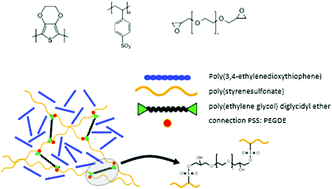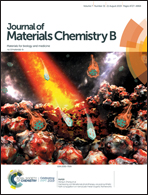PEDOT:PSS interfaces stabilised using a PEGylated crosslinker yield improved conductivity and biocompatibility†
Abstract
The rapidly expanding fields of bioelectronics, and biological interfaces with electronic sensors and stimulators, are placing an increasing demand on candidate materials to serve as robust surfaces that are both biocompatible, stable and electroconductive. Amongst conductive polymers, poly(3,4-ethylenedioxythiophene):poly(styrenesulfonate) (PEDOT:PSS) is a promising material in biomedical research due to its appropriate stability and high conductivity, however its intrinsic solubility requires a crosslinking process that can limit its conductivity and biocompatibility. Poly(ethylene glycol) is known to be a suitably anti-immunogenic moiety and its derivatives have been widely used for biomedical applications. In this study we investigate the application of poly(ethylene glycol)diglycidyl ether (PEGDE) as an effective crosslinker and conductive filler for PEDOT:PSS. From our interpretation of XPS analysis we hypothesise that the crosslinking reaction is occurring via the epoxy ring of PEGDE interacting with the sulfonic groups of excel PSS chains, which reaches a saturation at 3 w/v% PEGDE concentration. PEGDE crosslinked films did not disperse in aqueous environments, had enhanced electrical conductivity and imparted a significant degree of hydrophilicity to PEDOT:PSS films. This hydrophilicity and the presence of biocompatible PEGDE led to good cell viability and a significantly increased degree of cell spreading on PEDOT:PSS films. In comparison to widely reported chemical crosslinking via glycidoxy propyltrimethoxysilane (GOPS), this original crosslinking yields a highly hydrophilic 2D film substrate with increased electroconductive and biocompatibility properties, resulting in a next-generation formulation for bioengineering applications.

- This article is part of the themed collection: 2019 Journal of Materials Chemistry B Most Popular Articles


 Please wait while we load your content...
Please wait while we load your content...